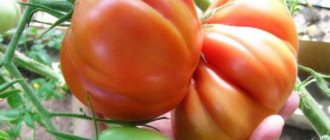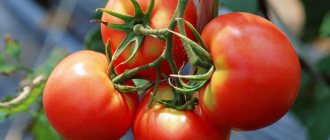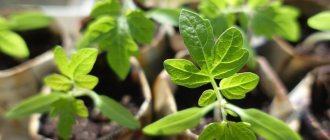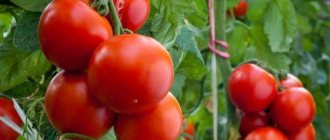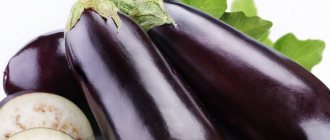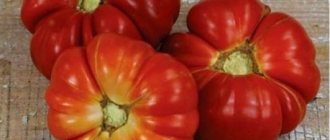How to choose the right variety of tomatoes Cream for open ground
Cream tomatoes, varieties of which are distinguished by visual brightness and taste, have the following advantages:
- approximately the same size of fruits, their uniform color and density, making cream a sought-after product;
- durable skin of the fruit, allowing you to obtain a high-quality canned product;
- transportability and possibility of long-term storage;
- rich composition of nutrients.
Cream fruits are devoid of the wateriness characteristic of traditional varieties of tomatoes, so they are perfect for fresh consumption, pickling and pickling. It is better not to use them for making juices.
As a garden crop, cream is famous for:
- high productivity;
- unpretentiousness;
- friendly ripening of fruits;
- versatility: you can grow oblong, elastic tomatoes in a greenhouse, open ground, on the terrace and windowsill of a city apartment;
- resistance to most nightshade diseases.
However, all the positive qualities of cream will appear only with the right choice of variety, which will correspond to the characteristics of the given area.
Growing conditions
Despite the oblong shape of the fruit and the general list of advantages, modern varieties and hybrids vary greatly in the requirements for growing conditions.
The main ones are:
| Conditions | Description |
| Optimal temperature | For most varieties, these are considered to be values in the range from 22° to 25°C; at higher values, the growth and development of tomato bushes slows down. If the thermometer drops below 12°C or rises above 35°C, it stops completely. However, there are varieties that can grow successfully in a wider temperature range. |
| Duration of the period | The time during which optimal temperature indicators are maintained. The vegetative period of the plant will depend on this parameter: the choice of an early-, mid- or late-ripening variety or hybrid. |
| Soil composition | To obtain tasty and beautiful fruits, 4 important elements must be present in the garden soil:
Basically, tomatoes prefer slightly acidic, light and loose soils, but there are unpretentious varieties that can “not notice” deviations from the ideal to a certain extent, and capricious varieties that will flatly refuse to grow in unsuitable soil. |
| Lighting requirements | A tomato of any variety will require a lot of sun; the length of daylight hours for it should not be less than 14-16 hours. For areas with an insufficient number of sunny days, hybrids have been created that can successfully bear fruit in extreme conditions. However, they are more often grown in protected soil. |
| Humidity Requirements | Optimal for tomatoes are average soil moisture levels (50%-60%). For air, this parameter should not exceed 70% or fall below 35%. At the same time, some varieties of cream easily tolerate short periods of drought or dampness, sudden changes in humidity, while others suffer from blossom end rot. |
Regional affiliation
When choosing a variety to grow in your garden plot, cream tomatoes require careful study of official recommendations. When entering a particular crop into the State Register, it is always indicated for which regions it is intended.
All peculiarities inherent in the selected regions are also taken into account:
- climate;
- soil composition;
- number of sunny days.
Also, tests must be carried out over several years to confirm the feasibility of growing a particular crop in these conditions. The gardener just has to make sure that the desired region is mentioned as recommended for growing the selected tomato variety.
You can also choose a variety intended for cultivation in a region with similar natural parameters, provided that existing deviations can be compensated for by performing agrotechnical procedures:
- drainage;
- liming;
- application of fertilizers.
Advantages and disadvantages
Of interest to summer residents are all the features of popular tomatoes.
| Advantages | Flaws |
| Excellent sweetish taste of dense pulp | Low juiciness, which does not allow tomatoes to be used for juice production |
| Simple agricultural cultivation technology | Carrying out for some tall species activities on pinching, gartering, shaping |
| High fruit resistance to cracking | |
| Friendly aging | |
| Preservation of commercial qualities of ripened tomatoes during transportation | |
| Stable high yield | |
| Versatility in use (canning, drying, preparing fresh salads, drying) | |
| Long-term storage of fresh tomatoes | |
| Rare pest damage, disease resistance |
Requirements for varieties for open ground
According to gardeners, tomatoes grown in open ground have higher taste qualities than their greenhouse counterparts. They contain more useful substances, but also require more complex care, which should compensate for the damage caused to plants by the vagaries of the weather.
Preference is given to the following varieties:
- early and mid-ripening, which will have time to ripen before the first cold weather. Late-ripening varieties can be planted in open ground only in the southern regions;
- short. They are unpretentious, hardy, and easy to maintain. If a tall variety is used, then tying and shaping the bush will need to be added to the list of mandatory care procedures;
- resistant to frost, the probability of which is high for most regions (with the exception of the southern regions);
- productive: if for greenhouse tomatoes it is possible to increase productivity by creating a special microclimate that prolongs the fruiting period, then in the case of ground tomatoes, productivity should be one of the varietal characteristics;
- immune to most garden pests and diseases, in particular to late blight, which invariably affects tomatoes in rainy summers.
Growing methods
Cream tomatoes (the varieties of these tomatoes are numerous and varied) can be grown in open ground in seedless and seedling ways. Each option has its own advantages and disadvantages.
Seedless method
It is practiced in the southern regions, where by mid-spring the soil has time to warm up to the desired temperature. It is possible to use the seedless method for the middle zone, but in this case you will have to choose early-ripening, cold-resistant varieties.
With the seedless plant method:
- are not injured during transplantation;
- grow stronger and more hardened;
- capable of bearing fruit until frost.
However, there is a high probability of seedling death, since it is not possible to accurately determine the optimal sowing date.
Seedling method
The method is applicable in any region; it is more labor-intensive, since it requires several additional operations:
- picks;
- hardening;
- landings in open ground;
- compliance with certain rules regarding the cultivation of seedlings.
Despite this, it is used more often because it allows:
- get the harvest earlier;
- grow varieties with any ripening period;
- achieve good germination rates;
- provide young plants with complete protection from unfavorable environmental conditions;
- discard non-viable plants in the early stages, saving space in the garden bed.
Among the disadvantages:
- high probability of injury to the roots during picking and disembarking;
- the need to purchase expensive substrates and containers for seedlings;
- additional time costs.
The optimal time to start growing seedlings is mid-March.
It will require:
- special nutrient substrate;
- containers with a side height of 10-12 cm;
- seeds.
Further actions are performed according to the following algorithm:
- Calibration to select viable seeds. To do this, they are lowered into warm salted water for several minutes (defective specimens will float to the surface).
- Disinfection in a slightly pink solution of potassium permanganate for 30 minutes.
- Planting in furrows 1 cm deep.
- The container is covered with film or glass, which is removed with the emergence of seedlings, first for a few minutes a day, then completely removed.
Young plants should be provided with the following growing conditions:
- temperature – 25°C;
- daylight hours - at least 12 hours;
- watering – moderate;
- feeding is regular.
The 1st time feeding is carried out when the first pair of leaves appears, the 2nd time - 2 weeks after picking, then - every 2 weeks, the last time - 10 days before planting in the ground. Nitrogen-containing mixtures are used for feeding. With the appearance of 2 pairs of true leaves, the seedlings are planted. Planting in the ground is possible in early to mid-May.
Seedlings ready for planting should have:
- height 30-35 cm;
- strong stems with a diameter of at least 8 mm;
- at least 4 pairs of leaves;
- rudiments of the first flower cluster.
In which regions of Russia can the Slivka tomato be grown?
The unique “Slivka” tomatoes can be cultivated in all regions, provided that climatic conditions are taken into account.
Ural
In the Ural territory, where an unstable harsh continental climate predominates, “Slivka” is used for growing all varieties of tomatoes using seedling technology. The seedlings are moved to greenhouses in May. Transplanting to open ridges is practiced in the first ten days of June.
Siberia
Summer residents successfully obtain a good harvest of tomatoes of the “Slivka” variety in Siberia using seedling technology. Grown seedlings are usually moved to the greenhouse after May 10. It is more difficult to grow tomatoes in beds, since you need to wait until the return frosts have completely stopped before planting seedlings. This period begins in mid-June. To preserve young plants, they install arcs on which spunbond sheets or film are stretched.
Moscow region and central Russia
In the vast Russian territory belonging to the central zone, including the Moscow region, the Slivka tomato is cultivated with good results in open beds. Seedlings are planted at the end of the spring season. In order to obtain earlier ripened fruits, greenhouses are used.
Southern regions of Russia
In the south, a variety of “Slivka” tomatoes are cultivated using the method of direct sowing on previously prepared beds. It is important to carry out this event in the last ten days of April, while the soil is saturated with sufficient moisture.
Features of planting and further care
Cream tomatoes, varieties of which require the creation of certain conditions, require advance preparation of the bed for them.
Preferably in the fall, allocating a place for them where they previously grew:
- pumpkin;
- legumes;
- cabbage;
- onion.
The selected site must meet the following requirements:
- good illumination throughout the day;
- loose, light soil with a slightly acidic reaction;
- groundwater level – at least 2 m from the surface;
- absence of strong wind and drafts;
- an area sufficient to plant the required number of tomatoes.
It is advisable to plant tomatoes away from potato plantations so that they do not become victims of the Colorado potato beetle and other pests of nightshade crops.
If necessary, perform:
- weeding;
- liming;
- treatment with insecticides or fungicides.
After these procedures, organic fertilizers are applied: manure, chicken droppings.
For the southern regions, seed planting using the seedless method of cultivation is carried out in April; in regions located to the north, planting must be waited until mid-May. 2 weeks before planting, wells are prepared into which a tablespoon of superphosphate is placed. The distance between the holes depends on the selected variety: the longer its growing season, the larger it is.
For early low-growing varieties, which are most often used in the seedless method, it is recommended to leave a distance between bushes of 30 cm with a row spacing of 50 cm.
Seeds before sowing for 30 minutes. soaked in a pale pink solution of potassium permanganate, after which they are dried and planted in prepared holes. The hatched seedlings are covered with “greenhouses” made from 6-liter plastic bottles with the bottom cut off.
2 weeks after the emergence of seedlings, the greenhouses are first removed for a few minutes, then the ventilation time is gradually lengthened. When the seedlings are strong enough, the bottles are removed.
With the seedling method, the holes are formed according to a pattern depending on the ripening time of the tomato:
- early varieties - 30 cm between holes, 50 - row spacing;
- medium varieties - 50 and 65 cm;
- late varieties - 50 and 75 cm.
The depth of the holes is chosen such that the root system of the seedling along with the earthen ball fits into it. To prevent it from crumbling during planting, the seedlings are watered shortly before planting. Next, all that remains is to carefully remove each plant from the pot and transplant it into the prepared hole, and then water it again.
Regardless of the planting method, further care of tomato bushes comes down to the following activities:
| Event | Description |
| Watering | This is carried out as the soil dries to maintain it in a moderately moist state; warm, settled water is used. The best method of watering is drip. Watering frequency is every 3-4 days, the amount of water for each bush is 2 liters (in the presence of rain), 4 liters (in dry summers). |
| Top dressing | Healthy plants will need 4 feedings per season:
To treat specimens weakened or affected by cold weather, you can use Epin Extra. Spraying is carried out weekly until complete recovery. |
| Mulching | It will protect the soil from drying out quickly. The following is used as mulch:
The mulch layer should cover the entire area around the bush, its thickness should be about 10 cm. |
| Loosening | Performed every week (the mulch is removed first). Its purpose is to break up the crust that forms on the soil surface, which impedes the supply of oxygen to the roots. |
| Tying and shaping bushes | For tall varieties, tying is used. For low-growing varieties, care is reduced to weekly removal of stepsons; tall tomatoes will require a more complex procedure. Depending on the characteristics of the variety, a formation of 1,2 or 3 stems is selected. |
Features of plum tomatoes
Cream is a high-yielding variety of tomatoes. The culture received its name due to its elongated fruits, which resemble the shape of a popular fruit. Cream has different colored pulp. Depending on the variety, like ordinary tomatoes, the fruits can be orange, red, etc. For some reason, many people prefer Pink Cream. Housewives say that these tomatoes are the most delicious and tender. The weight of the plum-shaped fruit ranges from 50–120 g. The vegetable is characterized by dense pulp and durable skin that does not crack during storage and transportation.
Long-term storage of Cream is due to the low moisture content in the pulp. Even if the fruit accidentally cracks due to mechanical stress, it does not leak heavily, as is observed in other varieties of fleshy tomatoes. Such a high level of marketability made Slivka popular among merchants. Housewives fell in love with the tomato because of its excellent taste, and made the vegetable universal. The cream is used for salting, canning, freezing and even drying. The small number of grains in the pulp makes the tomato popular among lovers of fresh cut vegetables.
There are many varieties of Cream intended for open ground and greenhouse cultivation. Some city housewives have adapted low-growing plants on their windowsills and balconies. The ripening time for Cream is the same as for regular tomatoes: early – up to 90 days, medium – up to 120 days, late – over 120 days.
Attention! Many plum varieties are susceptible to late blight and require mandatory treatment with drugs. The susceptibility of a crop to a particular disease is usually indicated on the seed packaging. The most resistant in this regard are hybrids.
The video provides an overview of the “Pink Cream” variety:
Diseases, pests and their control
Cream tomatoes (varieties of these tomatoes have good immunity and rarely suffer from late blight, fusarium, and root rot) can be susceptible to:
- infection with fungus and the development of cladosporiosis and brown spot. The main method of control is proper care and creation of conditions that provide unhindered access to the bushes of sunlight and fresh air;
- invasion of insect pests: cutworms and aphids. Before the fruits begin to set, you can get rid of them with the help of insecticides. Afterwards, you need to switch to harmless biological drugs or use folk remedies;
- the appearance of slugs and snails in tomato beds. Garlic infusion for spraying plants and dusting with ash have a repellent effect.
Variety of low-growing tomatoes
The choice of seed material for low-growing tomatoes today is extremely wide. Summer residents are offered varieties with different fruit colors: “classic” red, pink, orange, yellow, black...
The choice of low-growing tomato varieties today is extremely wide and includes a wide variety of colors, shapes and sizes of fruits
There are varieties and hybrids with fruits of various shapes and sizes, from the “cherry” variety, with small “berries,” to plants that form tomatoes weighing up to 300 g. The height of the bushes also varies:
- the most compact ones are 25-30 cm tall;
- there are forms reaching 90-100 cm.
The yield of plants also varies: it can be very modest, but the best varieties of low-growing tomatoes, with proper care, produce up to 9-10 kg of fruit per square meter.
Many home gardening enthusiasts successfully cultivate low-growing tomatoes on a windowsill or balcony.
The variety of methods for cultivating low-growing tomatoes is especially impressive. They are grown not only in protected and open ground. There are varieties that are perfect for cultivation on balconies and even indoors (in boxes or pots). Plants of this type are specially adapted to withstand a lack of light and “crowded” roots in a small clod of earth. In indoor cultivation, tomatoes usually develop as perennials: with proper care (regular watering and fertilizing), fruitful and “rested” plants regain the lost green mass and begin to actively form flower clusters.
Low-growing, ampel-type tomatoes are suitable for growing in hanging containers; they combine the properties of a vegetable and ornamental crop.
The latest developments of breeders have made it possible to develop low-growing varieties of hanging-type tomatoes, suitable for growing in hanging containers. They form compact bushes that form long, hanging flower clusters or lateral shoots, which bear a large number of small, but very beautiful and sweet fruits. Ampelous tomatoes combine the properties of a vegetable and ornamental crop. In addition, they almost do not suffer from late blight, since their stems and leaves practically do not come into contact with the soil.
Varieties of low-growing, small-fruited tomatoes are used to decorate home interiors and garden plots
“Traditional” varieties of low-growing, small-fruited tomatoes are also used to decorate garden plots: amateurs plant them in flower beds, where bushes strewn with bright fruits harmonize perfectly with decorative onions, ground cover and cereal plants.
We present brief descriptions and photos of low-growing tomatoes that have earned positive reviews from Russian gardeners.
The best varieties of tomato Cream for open ground
When choosing a cream tomato variety, you need to evaluate:
- its ability to grow in a given climate zone;
- duration of the growing season;
- height of bushes;
- fruit size;
- productivity;
- resistance to certain diseases.
Advance F1
Mid-season, unpretentious hybrid, intended for cultivation in the southern regions. He has proven himself well in the middle zone. Since it only requires compliance with basic rules of planting and care, it is the best option for an inexperienced vegetable grower.
Its characteristics:
- bushes: well-leafed, medium height, compact, allowing the most economical use of space in the garden bed;
- side shoots: do not extend far from the main stem, protecting ripening tomatoes from heat, which is especially important for the southern regions;
- fruits: slightly elongated, bright red in color, weigh 80-90 g, taste is assessed as excellent. Tomatoes ripen approximately 100-110 days from the moment the seeds are sown.
- yield - at least 200 c/ha.
Advance can be grown in seedlings and without seedlings, but the first option is preferable. Plants are extremely vulnerable to transplantation, so it is advisable to plant seedlings in peat pots. The optimal time for sowing seeds is the first days of March.
The seedlings will need lighting for 17 hours and a temperature of 19-25°C. With the appearance of 2-3 true leaves, it can be planted in open ground in a sunny place accessible to fresh air. Due to its compactness, 6 bushes can be placed per 1m2.
The fruits ripen almost simultaneously, harvesting can be scheduled for the end of June or beginning of July, provided that the integrity of the skin is preserved; Advance tomatoes are stored for about 2 weeks and can easily be transported.
Palmyra
A mid-season indeterminate (tall) and high-yielding variety that can be grown in open ground, in a greenhouse, or under film. It belongs to the raceme type tomatoes, it is recommended for cultivation in regions characterized by unstable summer temperatures and late spring; for the northern regions it is possible to grow it in protected soil.
Cream tomatoes. Variety Palmyra
The main characteristics are as follows:
- yield – 5 kg from 1 bush;
- vegetative period – 100-120 days;
- bushes can reach a height of 2 m;
- ripe fruits are yellow-orange in color, oblong with a pointed tip. Average weight – 80-100g, the pulp acquires an oily sheen when cut, the taste is assessed as pronounced, tomato;
- the fruits are formed in the form of a cluster; one cluster can contain 8-10 specimens.
Among the advantages:
- consistently high yields;
- immunity to common tomato diseases;
- ability for long-term storage;
- versatility.
Disadvantages include the labor intensity of cultivation, the need for garters and bush formation.
Palmyra is a pure variety, so independent preparation of seed material is possible. Seeds for seedlings are planted 60-65 days before the intended planting in the ground, diving is performed when two true leaves appear. Planting - when there are 7-8 leaves. On 1m2 you can place 3-4 bushes.
In the future, the plant will need:
- feeding during flowering and during the period of mass ripening of fruits;
- abundant watering (preferably by drip);
- formation of a bush (usually 2 stems);
- protection from insect pests.
Semalus F1
An early-ripening, heat-loving, low-growing hybrid intended for cultivation in the southern regions of the country. It is characterized as highly productive, resistant to viral diseases and unfavorable growing conditions.
Main characteristics:
- growing season - on average 115 days;
- bushes are compact, low-growing, their height does not exceed 80 cm;
- fruits are medium in size, regular plum-shaped and intense red in color, average weight is 100 g;
- the fruit pulp is dense, devoid of excessive wateriness, and rich red in color;
- the taste is assessed as pleasant, balanced, sweet and sour, with obvious “tomato” notes.
Among the advantages of the hybrid:
- high productivity;
- immunity to viral infections;
- ease of maintenance (no need for tying and complex formation of the bush);
- the ability to save space in the garden;
- simultaneous ripening of fruits.
The compactness of the bushes allows harvesting by mechanized means, so this hybrid is recommended for cultivation on an industrial scale.
When growing, the seedling method is mainly used; seeds for seedlings are sown 60-70 days before the expected date of planting in the ground. Planting is possible provided that the soil has warmed up to at least 10°C (at a depth of 10-12 cm). The optimal planting pattern is 50x40, planting density is no more than 7-9 specimens per 1 m2.
Further care for Semalus comes down to regular:
- watering;
- feeding;
- removal of stepchildren;
- protecting the plant from parasitic insects.
Benito F1
A mid-early hybrid that can produce a harvest within 3 months after planting. Developed in Holland and registered in the State Register in 2000 as a crop intended for cultivation in a number of regions, from the Central Black Earth to East Siberian and Far Eastern.
Main characteristics:
- vegetative period – 100 days;
- yield – up to 25 kg per 1 m2;
- bush – does not exceed 60 cm in height, foliage – average;
- leaf – large, dark green in color;
- the fruits are slightly elongated, cube-shaped, of a typical “tomato” color and weighing 40-70 g, collected in clusters of 7-9 pieces.
Thanks to its dense pulp, few seeds and tough skin, Benito is ideal for canning. Also, tomatoes of this type can be consumed fresh: the optimal ratio of sugars and acids gives them a taste that is invariably rated as excellent.
The most important features of the hybrid include:
- the ability to form fruits on shoots of all types and, accordingly, there is no need to remove stepsons;
- abundant and friendly fruiting (up to 20 fruits can be on the bush at the same time). For this reason, the bushes have to be tied up, despite their small size;
- unpretentiousness: the hybrid successfully bears fruit in cool climates and with a lack of sunlight. Benito is resistant to most nightshade diseases, with the exception of stolbur and blossom end rot, the prevention of which requires regular treatments;
- ability to bear fruit before frost. Fruits that do not have time to ripen before their onset ripen well during storage without losing their nutritional value;
- transportability;
- possibility of long-term storage.
In the south, Benito can be grown without seedlings; in the rest of the territory it is advisable to use seedlings, which begin to be grown in the second half of March. Seedlings can be planted in a common container: the seedlings do not show a tendency to outgrow and easily tolerate further planting in the ground.
Seeds are purchased in the store, do not require pre-sowing treatment, and are sown dry. Sprouts appear after 4-5 days and are then grown at room temperature. Picking is done after 10 days, watering as needed. Provided it is planted in a fertile substrate, fertilizing is not needed.
Planting seedlings in the ground can be done quite densely - 5 plants per m2.
In the future you will need:
- moderate watering followed by loosening;
- weeding;
- fertilizing with complex fertilizers throughout the season (from the 2nd half of summer - without nitrogen).
Watercolor
Created by Siberian breeders, this is a low-growing, early-ripening variety with a vegetative period of 120 days, consistently producing from 6 to 8 kg of small-sized fruits per 1 m2 (weighing, on average, 50 g) of a typical cream shape and rich red color. They are ideal for homemade preparations and for fresh consumption: the taste of ripe tomatoes was rated “excellent”.
Features of cultivation and care:
- the time required to obtain seedlings is 1.5-2 months;
- growing conditions – 23°C heat, sufficient light;
- density of planting in open ground – 6 copies per 1 m2;
- watering after planting - every 10-12 days, settled with warm water.
The variety can be cultivated throughout the country; it is unpretentious and has high yields with minimal care.
Attractive features of the variety:
- does not require pinching and, thanks to the powerful, massive stem, tying;
- not susceptible to blossom end rot, tobacco mosaic, septoria;
- on each fruiting shoot 6 fruits of the same size ripen;
- the first ovaries appear after the formation of 4-5 leaves.
A varietal characteristic is the presence of yellowish spots on ripe fruits located near the stalk.
Moscow region beds
In each region of Russia, summer residents have their own favorite varieties of tomatoes. If you consider the characteristics and description of the tomato variety Slivovka and others in the table below, you can understand why they are so attractive to gardeners in the Moscow region.
Tomatoes popular in the Moscow region
| Variety | Peculiarities |
| Slivovka | · An extra-early variety that produces a nice cream with a “spout.” The red fruits are smooth, slightly flattened at the stalk. They have low-juicy, fleshy pulp and a sour taste; |
| · Gardeners are attracted by its unpretentiousness, good immunity, the formation of ovaries, regardless of weather conditions, and the friendly yield of the harvest; | |
| · The fruits are marketable and transportable. If you pick them up from the bush when they are brown, they will rest quietly in the cellar until the beginning of winter. Good at preserving | |
| Cream Honey Tomato | · The hybrid variety is represented by determinate standard bushes. Despite their early maturity, they are grown not only in open ground, but also in greenhouses; |
| · The smooth red fruit with fleshy pulp has high tasting qualities and a pleasant aroma. A special feature of the Honey Cream tomato is the small number of chambers with seeds; | |
| · With tomatoes weighing up to 70 g, you can get about 4.5 kg from one square meter; | |
| · The variety is characterized by the following qualities: cream marketability, disease resistance, stable yield | |
| Moscow | · This is not just a variety - under this name there are several varieties of the crop, differing in color shades. The most popular among farmers are chocolate and yellow; |
| · Slivka Moskovskaya tomatoes have a sweetish taste with a slight piquant note, which allows the variety to be used more often than others for making ketchups and sauces; | |
| · The fruits are elastic, with low moisture content and a high percentage of glucose. At the time of ripening, tomatoes reach a weight of 130 g, which ensures good yield; | |
| · The variety is unpretentious to growing conditions, but has weak immunity to fungal diseases | |
| lady finger | · Determinate bush, up to 1 m high, bears fruit 3.5 months after planting. Graceful tomatoes are shaped like their name. Elongated tomatoes grow up to 8 cm in length and gain an average mature weight of 140 g; |
| · From one square meter, using conventional agricultural technology, a summer resident collects up to 6 kg of elastic fruits with a glossy skin. They are suitable for long-term transportation, retain marketability for a long time and have good taste. |
Having studied all the characteristics of tomatoes, gardeners select those that they like most. When choosing varieties for open ground, the emphasis is on regionality, because for areas with a short growing season you should not choose late-ripening Cream.
Price
The price of cream tomato seeds varies widely and depends on the manufacturer and packaging.
In particular, for the varieties described above it will be:
- Adavns F1 – 1033 rub. for 1000 pcs.;
- Palmyra – 27 rubles. per 0.2 g bag (about 10 seeds);
- Benito – 16 rubles. (pack of 10 seeds);
- Watercolor – 17 rub. (per package of 20 seeds).
There are a huge number of other varieties and hybrids of cream tomatoes that differ in size, color, taste, cultivation characteristics, and price of seed.
Secrets of Bountiful Harvests
To enjoy fresh tomatoes throughout the year, you should plant varieties with different fruiting periods. Plum-shaped tomatoes with small fruits grow well on a windowsill in winter, followed by greenhouse representatives of larger sizes with early and medium ripening periods. Many of them bear fruit until frost.
Whatever varieties and hybrids are chosen, all are grown through seedlings. March days are best for sowing plum tomato seeds.
The initial stage of cream tomatoes in Russian regions is no different from other varieties and hybrids. Sow seeds in soil rich in nutrients and set up a mini-greenhouse. The room temperature is maintained at least 25 degrees.
Good lighting (at least 14 hours of daylight) and timely feeding will allow tomato seedlings to develop well. Pale leaves and thin, elongated stems will signal a lack of light. Strong bushes with several true tomato leaves dive into separate pots.
The second stage is the active development of the tomato bush. During this period, the plant receives moisture and nutrition. The watering regime must be treated with particular care. Excess water provokes fungal infections in plum tomatoes. Loosening, mulching the soil and airing allow you to regulate the level of humidity around the seedlings. The optimal air humidity for plum tomatoes is 50-60%.
The third stage of tomato development is the planting of bushes in the ground in a permanent place immediately after spring frosts, usually mid-May or early June. By this time, the seedlings already have a developed root system, a strong trunk with a crown of several leaves. The planting pattern for plum tomatoes is checkerboard, the interval between holes depends on the dimensions of the future bush.
Every 14 days, tomato plantings are fertilized with complex compounds containing phosphorus and potassium. Nitrogen fertilizing is applied before flowering, so that the plant does not actively begin to grow its crown instead of fruits.
The bushes need a lot of sunlight. Lack of light will lead to loss of flower stalks and crops.
The fourth stage is the most enjoyable - harvesting. At this point, if there was enough light, nutrition and moisture, the tomato bushes look healthy, with beautiful, even, tasty tomatoes of the expected size hanging on them.
The temperature inside the greenhouse should not rise above 30 degrees. Pollen is sterilized at such temperatures and there will be no ovaries.
The temperature when growing tomatoes in greenhouses is regulated by ventilation, mulching the soil, and not watering. Watering should be regular and moderate. The volume of moisture increases slightly during the period of active fruit filling. Excess water will lead to shedding of flowers and ovaries, and very rarely to cracks in tomatoes.
Following simple rules will allow you to harvest an enviable harvest of plum tomatoes.
